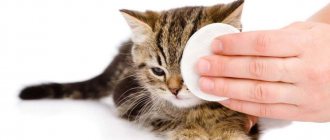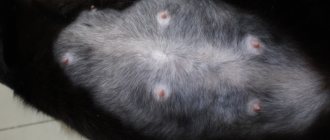Causes
A growth on a cat's paw Street
walkers are most susceptible to growths on the paw pads. But couch potatoes who never leave their apartment in a high-rise building are not immune from the disease.
Veterinarians report the following causes of growths:
- Foreign object: Most often, a splinter gets into the paw. The best scenario is suppuration, in which the foreign body is expelled. However, if the thorn does not cause inflammation and is encapsulated, it will constantly cause pain. The damaged area becomes overgrown with connective tissue, becomes rough, and interferes with movement.
- Ingrown claw: typical both for individuals predisposed to the disease and as a complication of an inflammatory disease of mycotic etiology. Sometimes the claw accidentally breaks off during the bully's adventures. The pathological process can occur with or without suppuration.
- The formation of a cutaneous horn is typical for adult pets older than 2 and younger than 7 years. If the growth does not interfere with walking, it is not noticed.
- Viral papillomatosis: occurs when the immune defense is weakened.
- Tumors: appear in pets who have crossed the ten-year mark. It is necessary to distinguish a benign growth from a malignant one.
How to treat cutaneous horn?
Use of veterinary drugs
According to veterinarian statistics, the pathology occurs mainly in Scottish and British cats, and in 5% of animals the growth degenerates into a malignant form.
All medications are prescribed by a veterinarian; self-medication is prohibited. To soften the skin horn and avoid secondary infection, Levomekol liniment should be applied. It has antibacterial properties and heals cracks. The growths are smeared 2-3 times. per day, wrapping the paw to prevent the cat from licking the ointment. Synthetic retinoids are also used to suppress the growth of growth. “Acitretin” is effective, which has regenerating properties and helps reduce keratinization. When a bacterial infection occurs, the pet is prescribed the antibiotic Azithromycin.
Surgery and laser treatment
If the formation grows, surgical intervention is used to remove the pathology.
If the cutaneous horn is very large or grows, surgery is performed to remove the affected skin. The area is stitched or cauterized with liquid nitrogen. After healing, a crust remains, which then falls off. However, cryotherapy is painful, so veterinarians recommend laser removal. The procedure is quick, does not cause pain, and does not leave wounds or scars.
Home therapy
Traditional medicine does not replace traditional treatment and should be agreed with a veterinarian. Popular and often recommended by incompetent people, lotions based on bay leaves or aloe are toxic to cats and can cause poisoning, impaired coordination of movements and seizures. Cutaneous horn on the pads of a cat can be effectively treated with vegetable oil. The liquid should be applied daily to the affected limb. A propolis compress helps, a piece of which should be wrapped with a bandage to the paw.
Symptoms
The cat holds up the damaged paw
Before detecting the growth itself, owners notice the following changes in the cat's behavior:
- constant licking of pads;
- lameness;
- plaintive meow;
- The cat tries to lean on the sore paw and hold it forever.
A preliminary diagnosis is made by the cat owner upon examination of the damaged paw. If the cause of pain is injury, the affected area is treated with an antiseptic wound healing agent.
Be sure to read:
Gingivitis in cats: how to recognize and treat the disease
When lumps or growths are found on the pads or between the toes, you should seek veterinary help.
Tumors by location
It is possible to guess the origin of the tumor based on its location, but this diagnostic method does not always work.
But there are still pathologies that most often appear on the front/hind legs.
On the front paw
Most often, tumors develop on the front paw for the following reasons (taking into account the possibility of the appearance of tumors):
- Injuries, including fractures.
- It is in the soft tissues of the front paws that splinters are most often found. They can cause both traumatic swelling and abscesses. The latter develop due to pathogenic microflora entering the wound canal. In the latter case, the tissues swell, become hot and thicken. As the abscess matures, it softens.
- Possible formation of hematomas. Due to strong impacts or other traumatic influences, blood vessels may be damaged. The blood coming out of them accumulates in the subcutaneous tissue and under the skin. In the first days the swelling is soft, after a few days it thickens and hardens.
On the hind leg
Tumors on the hind leg develop due to:
- The hind limbs very often become swollen and swollen in diseases of the heart and kidneys. The swelling is cold and dense.
- In addition, swelling of allergic origin often develops in the hind legs.
- Sometimes this is how myositis (muscle inflammation) manifests itself. These cases are characterized by severe pain.
All described pathologies can develop with equal probability on all paws.
Between the fingers
A tumor between the fingers is a common consequence of fungal pathologies. Malassezia is especially famous for this. This pathology, caused by yeast, is not typical for cats, but in practice it still occurs. Characterized by the following symptoms:
- Strange, lumpy growths appear in the spaces between the fingers.
- They are soft and “cheesy” to the touch.
- A strange, moldy, musty smell emanates from the paws of a sick animal.
Tumors in the interdigital spaces can be the result of allergies and abscesses due to foreign bodies entering the soft tissues. In the first case, the pathology is accompanied by severe itching, in the second, severe pain develops.
On the joint
A swelling or large lump on a joint is a sure sign that an animal’s limb is affected by arthritis, bursitis, arthrosis or other joint pathology.
All these diseases are accompanied by a pronounced pain reaction and severe lameness of the animal. In all cases, the tumor does not appear suddenly, but over a fairly long period of time. Older cats are most often affected.
Diagnosis and treatment
The reason for the formation of the growth is determined during a clinical examination taking into account the medical history. The blood is analyzed for viruses, and if necessary, a biopsy specimen is taken for histological examination.
The veterinarian decides what to do:
- Observe.
- Use conservative treatment methods.
- Remove the tumor surgically.
- Apply chemotherapy or radiation methods.
For conservative treatment, the veterinarian prescribes the following medications and monitors their use:
- Retinoids: Acitretin or Etretinate. Prevents keratinization and pathological tissue proliferation.
- Aldara is an immunomodulating cream, a non-specific agent that increases the body's resistance to viruses, fungi and bacteria.
- Azithromycin is an antibiotic. The veterinarian selects the dosage and course of treatment individually.
When surgically removing a tumor, the following methods are used:
- laser burning;
- cryotherapy with liquid nitrogen;
- excision - used for extensive growth of pathological tissue.
If after removal of the tumor it grows back, radiotherapy or chemotherapy is prescribed.
How is the treatment carried out?
Medications
When cutaneous horn appears in cats, you should immediately see a veterinarian, who will conduct examinations and select therapeutic measures. In the early stages, papillomas can be treated with medication. Treatment involves the use of a number of drugs indicated in the table:
| Drug group | Name |
| Immunostimulating agents | "Kanina" |
| "Gamavit" | |
| "Maksidin" | |
| "Ronkoleikin" | |
| Ointments and solutions with antiseptic action | "Chlorhexidine" |
| "Dekasan" | |
| "Betadine" | |
| Hydrogen peroxide | |
| "Pantestine" |
Novocaine solution is often used to eliminate formations in an animal.
Often, Novocain is injected into a vein to treat benign growths on a cat’s skin. A solution of 0.5-1% is suitable for therapy, with the dosage calculated at 1 ml per 1 kg of cat. The medicine is administered three times, maintaining an interval between injections of 2-3 days. It is also possible to inject Novocaine under the papilloma itself.
Surgical removal: when is it required?
Veterinarians advise that owners remove warts from cats surgically, which is more effective, and after this method of treatment there is less recurrence. Removal is performed in several ways:
- use of liquid nitrogen at low temperatures;
- laser cauterization;
- radiation.
For a speedy recovery of cats after removal of papillomas, it is recommended to give them immunostimulant vitamins and mineral supplements.
The effectiveness of folk remedies
If the virus has just begun to spread throughout the animal’s body, then the first growths can be treated with garlic juice.
In the early stages, it is possible to cope with papillomatosis in cats at home, using natural ingredients. Papillomas are treated with iodine and other folk remedies are used, such as:
- fresh celandine juice;
- spurge;
- garlic juice;
- a drop of acetic acid;
- rowan berries.
Prevention
To prevent growths on the paws, observe the cat’s behavior. If the pet is limping or holding its paw suspended, treat it with an antiseptic aerosol with wound-healing properties.
To prevent the formation of a capsule or rough scar. A broken claw can be trimmed independently or with the help of a specialist. If the pet does not go outside, monitor the condition of the claws, trim them, and install a scratching post.
They provide complete feeding with ready-made food of at least premium class or create a diet balanced in all respects from natural products. Monitor the cat's supply of vitamin A.
Can a person become infected?
The papillomavirus, which leads to pathology in cats, does not pose a threat to the human body, since it only affects members of the cat family. Such pathogenic microorganisms are not even capable of being transmitted from cat to dog. Therefore, when the first papillomas are detected, the pet owner should not be afraid of infection, but immediately take the cat and go to the veterinary clinic in order to carry out treatment on time and prevent complications. If you are sick, you should carefully monitor the hygiene of the cat’s ears, paws and other parts of the cat’s body, and a sick animal needs good care for a speedy recovery.
Skin Diseases of the Paw Pads in Cats With Photos
РҐРѕСЃС‚РеРЅРі сайта временно приостановлен
Если РІС‹ владелец РґР°РСРЅРѕРіРѕ SЂРµСЃСѓСЂСЃР°, то для возобновлен РёСЏ работы сайта вам необС...РѕРґРѕРјРѕ продлостдействме SѓСЃР»СѓРіРѕ S…остинга.
Р' случае, если приостановка работы сайта вызвана РЅР°СЂС ѓС€РµРЅРёРµРј SѓСЃР» РѕРІРёР№ логовора РЅР° абонентское обслужРевание, то для РІРѕР· обновления работы вам неоР±С…РѕРґРёРјРѕ обратиться РІ Службу RїРѕРґРґРµСЂР¶РєРё. RњS‹ R±SѓРґРµРј SЂР°РґС‹ RІР°Рј RїРѕРјРѕС‡СЊ!
Если РІС‹ уверены, что это недоразумение Рели ошибка, напишите РІ Службу поддерж РєРё Р' РїРёСЃСЊРјРµ РЅРµ забудьте SѓРєР°Р·Р°С‚СЊ SЃСЃС‹Р»РєСѓ РЅР° страницу.
Р' случае, если приостановка работы сайта вызвана РЅР°СЂС ѓС€РµРЅРёРµРј SѓСЃР» РѕРІРёР№ логовора РЅР° абонентское обслужРевание, то для РІРѕР· обновления работы вам неоР±С…РѕРґРёРјРѕ обратиться РІ Службу RїРѕРґРґРµСЂР¶РєРё. RњS‹ R±SѓРґРµРј SЂР°РґС‹ RІР°Рј RїРѕРјРѕС‡СЊ!










